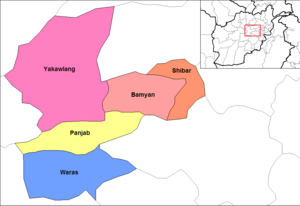| Revision as of 13:49, 28 November 2007 editDreamOfJeannie (talk | contribs)41 edits sorry, Dari is the official name.← Previous edit | Revision as of 13:50, 28 November 2007 edit undoBeh-nam (talk | contribs)8,290 edits rv, the official name of this langage WORLWIDE is Persian. there is concensus over this all over Afghanistan related articlesNext edit → | ||
| Line 14: | Line 14: | ||
| }} | }} | ||
| '''Bamiyan Province''' (]: بامیان) is one of the thirty-four ]. It is in the centre of the country. Its capital is also called ]. Bamiyan is the largest town in the ] region of ], and is the cultural capital of the ] ethnic group that predominates in the area. | '''Bamiyan Province''' (]: بامیان) is one of the thirty-four ]. It is in the centre of the country. Its capital is also called ]. Bamiyan is the largest town in the ] region of ], and is the cultural capital of the ] ethnic group that predominates in the area. | ||
| In antiquity, central Afghanistan was strategically placed to thrive from the ] caravans which criss-crossed the region trading between the Roman Empire, China, Central and South Asia. Bamyan was a stopping off point for many travellers. It was here where elements of Greek, Persian and Buddhist art were combined into a unique classical style, known as ] art. | In antiquity, central Afghanistan was strategically placed to thrive from the ] caravans which criss-crossed the region trading between the Roman Empire, China, Central and South Asia. Bamyan was a stopping off point for many travellers. It was here where elements of Greek, Persian and Buddhist art were combined into a unique classical style, known as ] art. | ||
Revision as of 13:50, 28 November 2007
Template:Infobox Administrative Division 1
Bamiyan Province (Persian: بامیان) is one of the thirty-four provinces of Afghanistan. It is in the centre of the country. Its capital is also called Bamiyan. Bamiyan is the largest town in the Hazarajat region of Afghanistan, and is the cultural capital of the Hazara ethnic group that predominates in the area.
In antiquity, central Afghanistan was strategically placed to thrive from the Silk Road caravans which criss-crossed the region trading between the Roman Empire, China, Central and South Asia. Bamyan was a stopping off point for many travellers. It was here where elements of Greek, Persian and Buddhist art were combined into a unique classical style, known as Greco-Buddhist art.
History
Bamiyan was the site of an early Buddhist monastery. Many statues of Buddha are carved into the sides of cliffs facing Bamiyan city. The two most prominent of these statues were standing Buddhas, now known as the Buddhas of Bamiyan, measuring 55 and 37 meters high respectively, that were the largest examples of standing Buddha carvings in the world (see also:). They were probably erected in the 4th or 5th century C.E. They were cultural landmarks for many years and are listed among UNESCO's World Heritage Sites. In March 2001 the Taliban government decreed that the statues were idolatrous and ordered them to be demolished with anti-aircraft artillery and explosives.

Bamiyan is also known for its natural beauty. The Band-e Amir lakes in western Bamiyan province continue to be a tourist destination for Afghans.

Bamiyan is currently the base of operations for the New Zealand peace keeping force, a Provincial Reconstruction Team codenamed Task Group Crib, which is part of the network of Provincial Reconstruction Teams throughout Afghanistan. It is recognised as one of the safest provinces in the country which has allowed for much concerntration on civil rebuilding
There are currently 122 New Zealand Defence Force personnel in Bamiyan. To date they have helped with reconstruction work including building bridges and schools as well as maintaining security in the region.
The New Zealand Police are also working in the region to help train the Afghan National Police (ANP). In July 2006 three Afghan women signed to join the ANP in Bamiyan, the first time women have joined a police force in Afghanistan.
Politics
The current governor of the province is Habiba Sarabi, Afghanistan's first female governor. She was appointed in 2005.
Districts
- Bamiyan (Capital - 61,863)
- Kahmard (17,643)
- Panjab (47,099)
- Sayghan (18,001)
- Shibar (25,177)
- Waras (81,787)
- Yakawlang (65,573)

External links
- Dupree, Nancy Hatch (1977): An Historical Guide to Afghanistan. 1st Edition: 1970. 2nd Edition. Revised and Enlarged. Afghan Tourist Organization.
- Bamiyan-Development Community Portal for cultural heritage management of Bamiyan
- Afghanistan Information Management Services - Bamyan Province
| Provinces of Afghanistan | ||
|---|---|---|